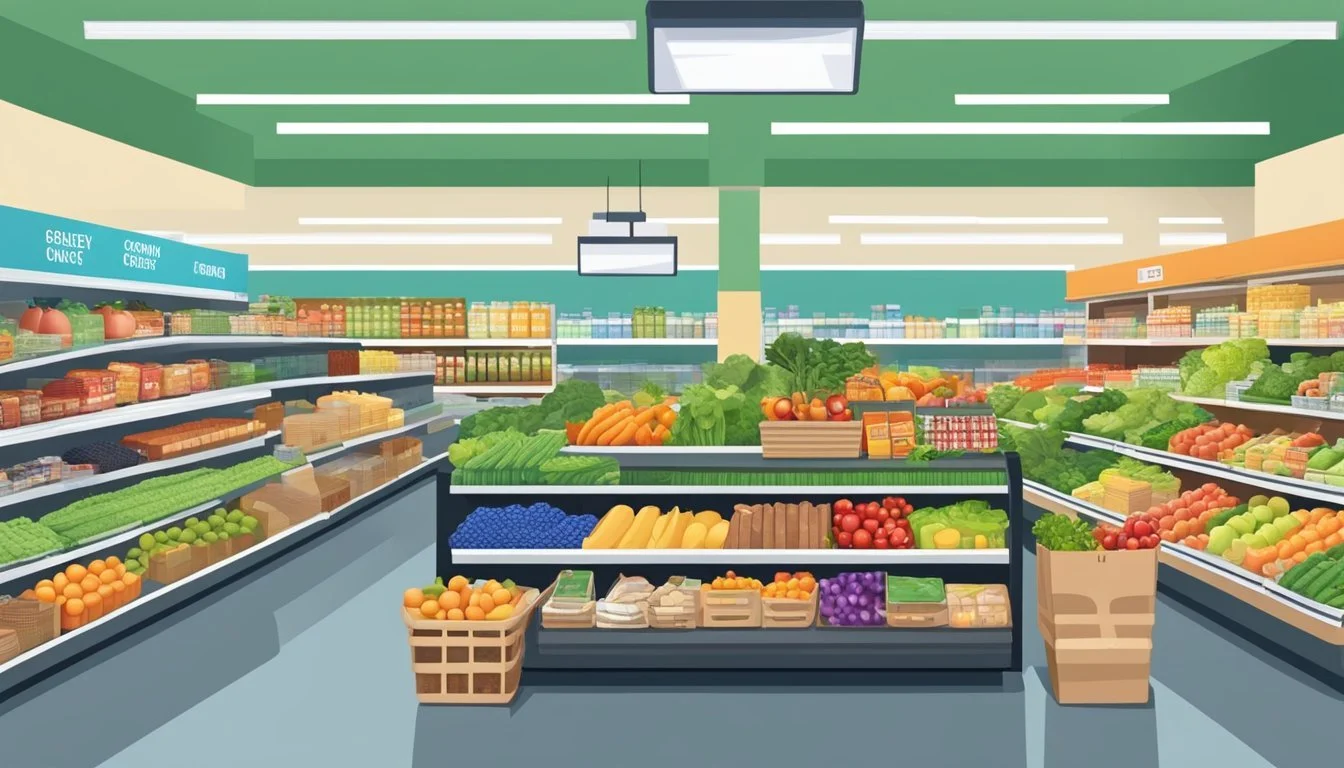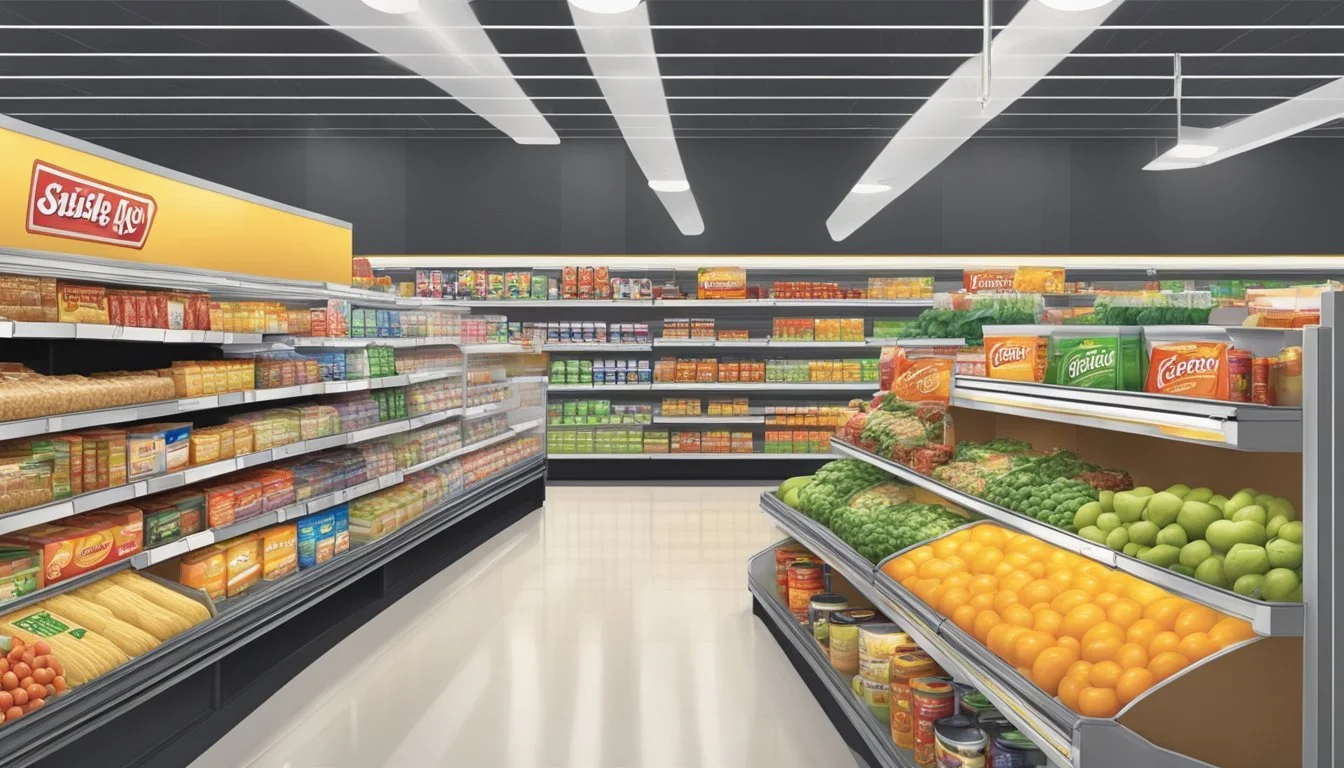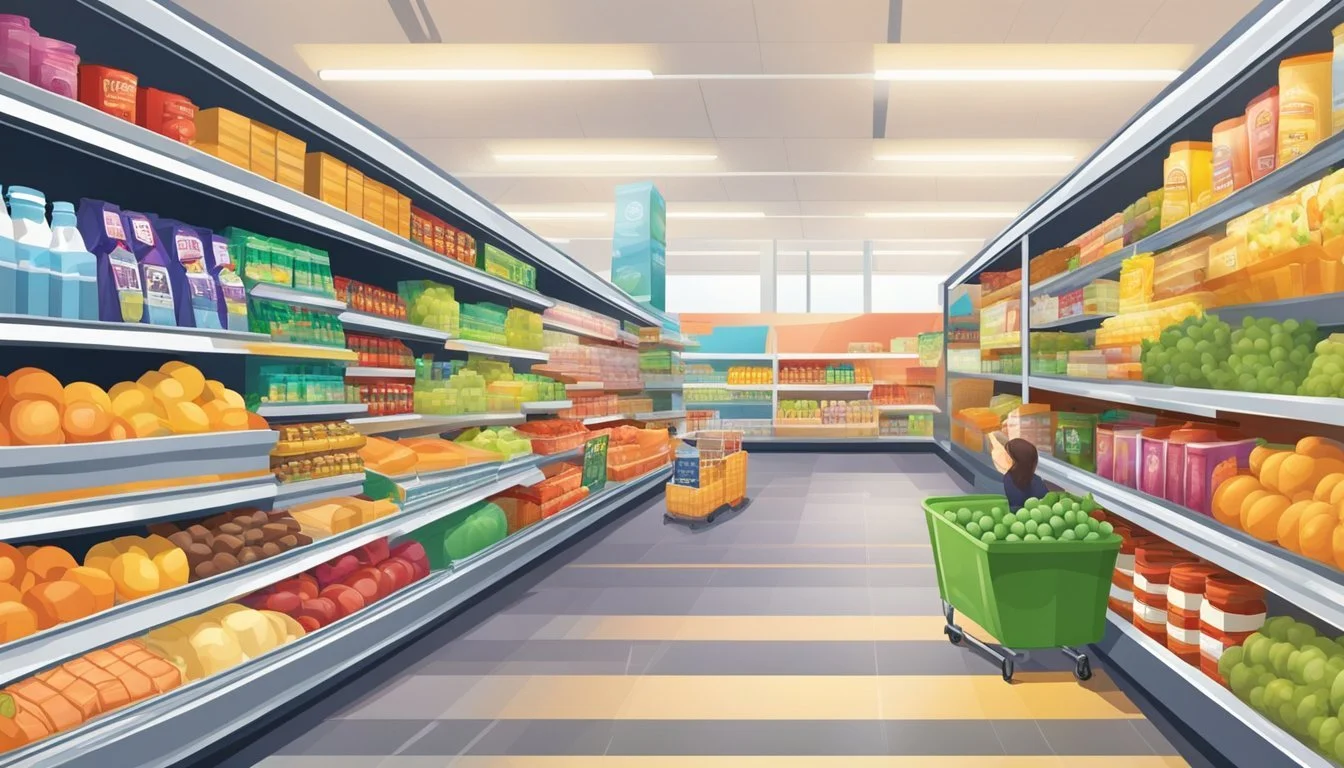FoodMaxx vs Giant Food
Comparing Prices, Selection, and Quality
Choosing the right grocery store can significantly impact your budget and shopping experience. FoodMaxx and Giant Food are two popular options that offer different advantages to consumers.
FoodMaxx tends to be cheaper overall, with prices typically 21% lower than average grocery stores. This discount retailer focuses on providing low-cost groceries and household essentials. Giant Food, on the other hand, is known for its wider selection and higher-quality produce, though at slightly higher prices.
Both stores have their strengths and weaknesses. FoodMaxx appeals to budget-conscious shoppers looking to save on everyday items. Giant Food caters to those who prioritize variety and are willing to pay a bit more for a broader range of products and services. The best choice depends on individual preferences and shopping habits.
Overview of FoodMaxx and Giant Food
FoodMaxx and Giant Food are two distinct grocery store chains operating in different regions of the United States. Both companies have established themselves as prominent players in the supermarket industry, catering to diverse customer needs.
History and Expansion
FoodMaxx emerged as a discount grocery store brand under The Save Mart Companies umbrella. Founded in Modesto, California, FoodMaxx has focused on providing low-cost groceries to budget-conscious shoppers since its inception.
The chain expanded throughout northern and central California, becoming known for its no-frills approach and competitive pricing.
Giant Food, on the other hand, has a longer history dating back to 1936. The company was founded in Washington, D.C. and grew to become a major supermarket chain in the mid-Atlantic region.
Giant Food experienced significant expansion over the decades, opening stores in Maryland, Virginia, and Delaware.
Store Presence
FoodMaxx operates primarily in California, with a strong presence in the northern and central parts of the state. The chain is part of The Save Mart Companies, which also owns Save Mart and Lucky supermarkets.
FoodMaxx stores are typically found in urban and suburban areas, offering a wide range of grocery items at discounted prices.
Giant Food has a more extensive network of stores spread across the mid-Atlantic region. The company maintains a significant presence in Maryland, Virginia, Delaware, and the District of Columbia.
Giant Food stores are often larger than FoodMaxx locations, providing a broader selection of products and services, including pharmacies and fuel stations at some locations.
Assessing Product Quality
Product quality is a crucial factor when comparing grocery stores. FoodMaxx and Giant Food both strive to offer fresh, high-quality items across their departments, but there are some key differences to consider.
Meat and Produce Standards
FoodMaxx emphasizes value, offering competitive prices on meats and produce. Their meat selection includes both conventional and some organic options. The produce section features a mix of conventional and seasonal items.
Giant Food puts a strong focus on freshness and quality. They source meats from reputable suppliers and offer a wider range of premium and organic cuts. Their produce department is known for high-quality fruits and vegetables, with an emphasis on locally sourced items when available.
Both stores maintain proper temperature control and rotation practices for perishables. However, Giant Food tends to have stricter quality control measures in place.
Bakery and Deli Offerings
FoodMaxx typically has a more limited bakery and deli section compared to Giant Food. They offer basic bread, rolls, and pastries, along with a standard selection of deli meats and cheeses.
Giant Food boasts a more extensive bakery department with artisanal breads, custom cakes, and a variety of pastries. Their deli section often includes:
Premium sliced meats and cheeses
Prepared salads and side dishes
Hot food bars with rotisserie chickens and daily specials
The quality of ingredients and variety of options tend to be higher at Giant Food.
Prepared Foods and Organic Options
FoodMaxx offers a basic selection of prepared foods, focusing on convenient, budget-friendly options. Their organic selection is growing but remains limited compared to some competitors.
Giant Food provides a wider array of prepared foods, including:
Fresh sushi
Made-to-order sandwiches
Gourmet meal kits
They also have a robust organic section featuring produce, dairy, meats, and pantry staples. Giant Food's commitment to organic and natural products is more pronounced, catering to health-conscious shoppers.
Both stores maintain food safety standards for prepared items, but Giant Food's broader selection and emphasis on premium ingredients give it an edge in this category.
Pricing and Affordability
FoodMaxx and Giant Food employ different pricing strategies to attract budget-conscious shoppers. Both stores offer competitive prices, but their approaches to deals and savings programs vary.
Everyday Prices and Deals
FoodMaxx focuses on consistently low everyday prices across its product range. The store emphasizes a no-frills shopping experience, passing savings to customers through reduced overhead costs.
Giant Food, in contrast, uses a mix of regular prices and weekly sales. Their circular ads feature rotating deals on popular items, allowing savvy shoppers to stock up when prices dip.
FoodMaxx often prices staple items like milk, bread, and eggs lower than competitors. Giant Food counters with frequent buy-one-get-one-free promotions on name-brand products.
Savings Programs and Discounts
Giant Food offers a robust loyalty program through their store card. Members earn points on purchases, which can be redeemed for gas discounts or groceries.
The store also provides digital coupons and personalized offers based on shopping history. Senior citizens receive an additional discount on certain days.
FoodMaxx takes a simpler approach, avoiding loyalty programs in favor of across-the-board low prices. They occasionally offer manufacturer coupons but focus primarily on keeping base prices down.
Price Comparison and Competitive Analysis
Studies show FoodMaxx typically beats Giant Food on overall basket price. One comparison found FoodMaxx prices about 21% lower than average grocery stores in the area.
Giant Food's prices tend to be closer to standard supermarket rates, but strategic shopping during sales can yield significant savings.
Common items price comparison:
Milk (1 gallon): FoodMaxx $2.99, Giant Food $3.49
Bread (store brand): FoodMaxx $1.29, Giant Food $1.79
Eggs (1 dozen): FoodMaxx $2.49, Giant Food $2.99
The price difference is most noticeable on store-brand and basic grocery items, where FoodMaxx consistently undercuts competitors.
Customer Shopping Experience
FoodMaxx and Giant Food offer distinct shopping experiences for customers. Key differences emerge in service quality, store environments, and overall customer satisfaction.
Service and Checkout Efficiency
FoodMaxx emphasizes a no-frills approach, often resulting in shorter checkout lines. Self-service options are common, allowing customers to bag their own groceries. This can lead to quicker transactions for those comfortable with the process.
Giant Food typically provides more staff assistance. Dedicated baggers and multiple checkout lanes are standard features. During peak hours, Giant Food may open additional registers to manage customer flow.
Both stores have implemented self-checkout kiosks in many locations. These options cater to shoppers seeking a speedy exit, particularly those with fewer items.
Store Cleanliness and Layout
FoodMaxx stores generally have a warehouse-style layout. Aisles are wider to accommodate pallets and bulk displays. This design can make navigation straightforward but may feel less polished.
Giant Food opts for a more traditional grocery store layout. Departments are clearly defined, with produce, bakery, and deli sections often positioned prominently. Signage tends to be more extensive, aiding in product location.
Cleanliness standards vary by individual store rather than chain-wide policies. Regular inspections and customer feedback influence maintenance practices at both retailers.
Customer Satisfaction and Ratings
Consumer surveys indicate mixed results for both chains. FoodMaxx often scores well on price satisfaction but may lag in customer service ratings. Shoppers appreciate the cost savings but sometimes report feeling rushed.
Giant Food typically receives higher marks for product variety and store atmosphere. Customers value the broader selection of national brands and prepared foods. The chain's loyalty program is frequently cited as a positive factor.
Online reviews reflect these trends, with FoodMaxx garnering praise for affordability and Giant Food for its overall shopping environment. Both stores face challenges in maintaining consistent experiences across all locations.
Brand and Product Selection
FoodMaxx and Giant Food offer distinct approaches to product selection and store brands. Each chain aims to meet customer needs through a mix of national brands, private labels, and exclusive product lines.
Exclusive Brands and Product Lines
FoodMaxx focuses on providing affordable options through their private label products. They offer a range of store-brand items across various categories, including dairy, frozen foods, and pantry staples. These products typically come at lower price points compared to national brands.
Giant Food, on the other hand, has developed a more extensive lineup of exclusive brands. Their Nature's Promise line features organic and natural products, while the Taste of Inspirations brand offers premium specialty items. Giant also carries Simple Truth products, a natural and organic brand shared with other Kroger-owned stores.
Variety and Availability of Products
FoodMaxx stores generally stock a more limited selection of products compared to Giant Food. They prioritize high-turnover items and bulk purchases to keep costs down. Their meat department offers budget-friendly cuts and family-sized packages.
Giant Food provides a wider variety of products, including specialty and gourmet items. They typically have larger produce sections with more organic options. Giant stores often feature expanded departments for prepared foods, bakery items, and deli selections.
Both chains carry national brands, but Giant Food tends to offer a broader range of choices. Giant also frequently updates its inventory to include trendy or seasonal products, while FoodMaxx maintains a more consistent selection of everyday essentials.
Promotions and Marketing Strategies
FoodMaxx and Giant Food employ various tactics to attract and retain customers. Both chains utilize loyalty programs, targeted marketing campaigns, and strategic pricing to drive sales and build brand loyalty.
Loyalty Programs and Marketing Campaigns
FoodMaxx offers a digital rewards program where customers earn points on purchases. These points can be redeemed for discounts on future shopping trips. The chain also sends personalized digital coupons to members based on their shopping habits.
Giant Food's loyalty program, Giant Choice Rewards, provides similar benefits. Members earn points on purchases and receive tailored offers. Giant Food also runs targeted email and social media campaigns to promote weekly specials and seasonal items.
Both stores leverage their websites and mobile apps to showcase deals and allow customers to create digital shopping lists. These platforms serve as key marketing channels, delivering promotions directly to shoppers' devices.
Loss Leaders and Sales Events
FoodMaxx is known for its everyday low prices strategy. The chain frequently uses loss leaders, selling popular items at or below cost to attract customers. These often include staples like milk, eggs, and bread.
Giant Food runs regular weekly sales events, typically starting on Fridays. The store features "Buy One, Get One Free" deals and significant discounts on select items. Giant Food also hosts seasonal promotions, such as summer grilling events or holiday baking sales.
Both chains strategically place sale items throughout the store to encourage additional purchases. End-cap displays and prominent signage highlight these deals, aiming to boost overall basket size while providing value to shoppers.
Convenience and Shopping Options
FoodMaxx and Giant Food offer different levels of convenience and shopping options to meet customer needs. Both chains provide in-store and online solutions, but their offerings vary in scope and availability.
Online Shopping and Delivery Services
FoodMaxx provides limited online shopping options. Customers can browse weekly ads and create shopping lists on the FoodMaxx website. However, home delivery services are not widely available.
Giant Food offers more comprehensive online shopping. Customers can order groceries through the Giant Food website or mobile app. Same-day delivery is available in many areas. Giant Food also partners with Instacart for additional delivery options.
Both stores offer curbside pickup services at select locations. This allows customers to order online and collect their groceries without entering the store.
Physical Store Accessibility and Convenience
FoodMaxx operates fewer stores compared to Giant Food, primarily in California and Nevada. Store layouts focus on a no-frills approach, emphasizing low prices over ambiance.
Giant Food has a larger presence in the mid-Atlantic region. Stores are typically larger and offer a wider range of departments and services. Many Giant Food locations include pharmacies, fuel stations, and prepared food sections.
Both chains provide ample parking at most locations. Store hours vary by location, with many FoodMaxx stores open until midnight. Giant Food stores often have extended hours, with some locations open 24 hours.
Sustainability and Ethical Practices
FoodMaxx and Giant Food have implemented various sustainability initiatives and ethical practices. These efforts impact their sourcing policies, environmental footprint, and approach to animal welfare and food production ethics.
Sourcing Policies and Environmental Impact
FoodMaxx prioritizes local sourcing to reduce transportation emissions. The company has installed energy-efficient lighting and refrigeration systems in its stores. They've also implemented a recycling program for cardboard and plastics.
Giant Food has made strides in sustainable packaging. They've introduced reusable produce bags and encourage customers to bring their own shopping bags. The chain has committed to reducing food waste by 50% by 2030.
Both retailers offer organic produce sections, though Giant Food's selection is typically larger. Giant Food has also pledged to source 100% sustainable seafood by 2025.
Animal Welfare and Food Production Ethics
FoodMaxx offers some grass-fed meat options but has not made specific commitments regarding growth hormones or antibiotics use. They carry cage-free eggs in response to customer demand.
Giant Food has taken a stronger stance on animal welfare. They've committed to sourcing only cage-free eggs by 2025. The chain also offers a line of antibiotic-free meats and has pledged to eliminate gestation crates in their pork supply chain.
Both retailers carry some ethically-sourced products, but Giant Food appears to have more robust policies in place. They've partnered with fair trade organizations to ensure ethical sourcing of products like coffee and chocolate.
Comparative Analysis of FoodMaxx and Giant Food
FoodMaxx and Giant Food offer distinct shopping experiences for customers seeking quality groceries at competitive prices.
FoodMaxx is known for its no-frills approach, focusing on providing low prices across a wide range of products. Their stores often feature a warehouse-style layout, emphasizing bulk purchases and discounted items.
Giant Food, on the other hand, presents a more traditional supermarket format with a greater emphasis on customer service and store ambiance. They typically offer a broader selection of name-brand products and fresh produce.
Price comparison studies indicate that FoodMaxx generally maintains lower prices than Giant Food. One analysis found FoodMaxx prices to be approximately 21% below the average of surveyed stores in the area.
Both chains face stiff competition from larger retailers like Walmart and Kroger. Walmart, in particular, often matches or beats FoodMaxx prices while offering a more extensive product range.
FoodMaxx's pricing strategy aligns closely with other discount grocers such as WinCo and Grocery Outlet. These stores prioritize cost savings over amenities, appealing to budget-conscious shoppers.
Giant Food competes more directly with mid-range supermarkets like Safeway and Publix. They aim to balance competitive pricing with a more upscale shopping environment and wider selection of specialty items.
Customer loyalty programs differ between the two chains. Giant Food typically offers more robust rewards and personalized discounts, while FoodMaxx relies primarily on its everyday low pricing model.







